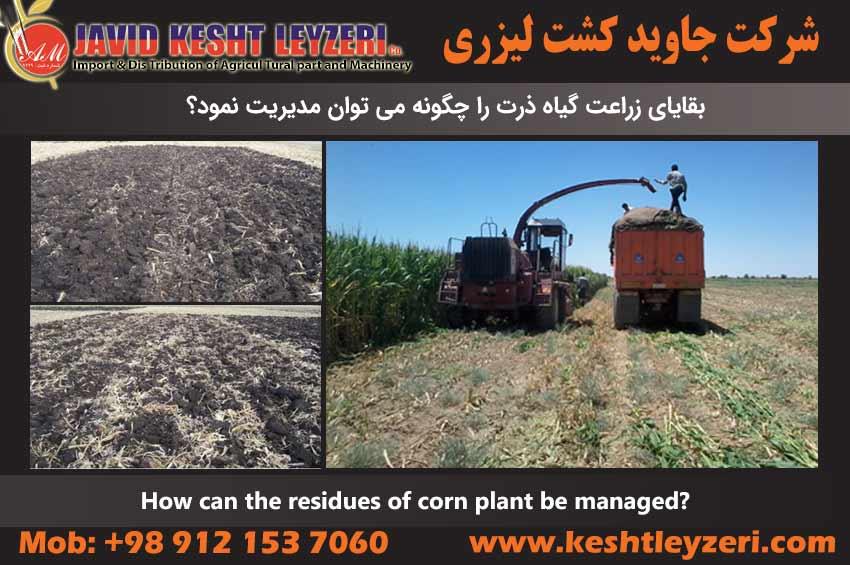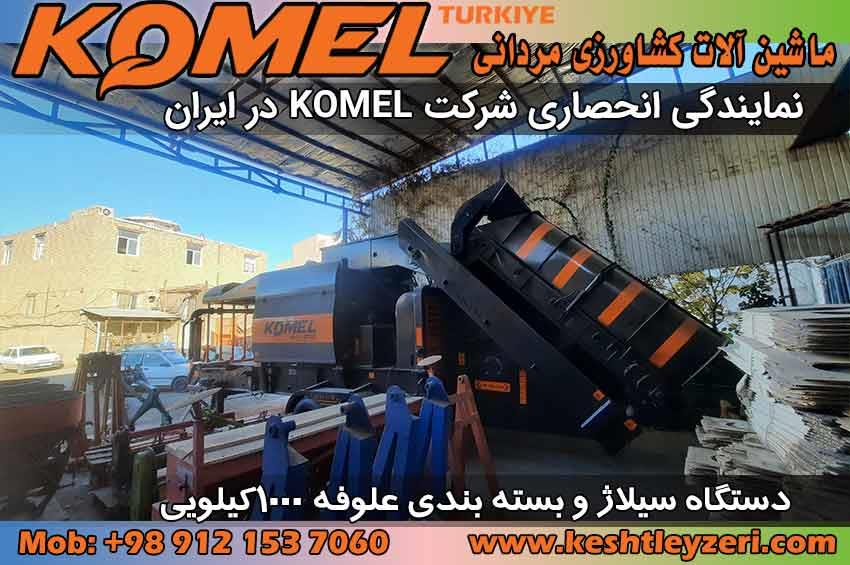
How can the residues of corn plant be managed?
javid keshtleyzeri Co.ltd
List of contents presented in this section:
What is the necessity of managing plant residues of corn cultivation?
How is the management of sustainable harvesting of corn plant residues?
What is the allowed amount of harvestable residues from corn cultivation?
What are the factors affecting the harvest of corn residues?
What are the methods of harvesting corn residues?
How much is the cost of removing the remains of the corn plant?
How useful is the harvesting of corn cob wood as the residue of corn plant cultivation?
In the following, the above contents will be reviewed.
What is the necessity of managing plant residues of corn cultivation?
Management of plant residues of corn cultivation is very important. This action helps to improve soil health, prevent weeds and diseases, preserve biodiversity, and increase crop productivity in areas such as grain production, animal feed supply, and saving water resources. An operation such as decomposition of plant residues in the soil can absorb and preserve water and organic matter and also increase soil nitrogen. You can use methods such as mulching, anticide, and mulching to manage plant debris.
Considering that in Iran, most of the corn farmers add residues and corn residues to the soil, and the harvesting of residues is done as a source of food for silage or livestock grazing in some areas, it seems that in the near future, with industrial advances in conversion industries and Agriculture-related industries, interest in harvesting residues for use as a raw material in the production of paper pulp or bioethanol will increase among corn farmers. In addition, the increase in production costs in the agricultural sector due to these industrial changes will likely place more emphasis on managing agricultural residues in corn fields and maintaining soil organic matter to prevent soil erosion and increase soil fertility and crop yield. In this regard, a proper balance should be struck between short-term commercial outlook and long-term economic sustainability, and soil organic matter should be preserved and protected during harvest of residues so that they can be used in the future.
Almost 45% of the total yield of dry matter of corn consists of corn kernels. In a field where corn seed yield is 15.5 tons per hectare, dry corn residue is approximately 12 tons. In order to convert the weight of the dry matter to the actual weight, the moisture content must be taken into account. The general rule says: the amount of moisture in the stem and leaves of corn is almost twice as much as the moisture in the grain. Considering that the seed is harvested with 20% moisture, the stalk and leaves of corn in this farm have almost 40% moisture. Therefore, 12 tons of dry residue, considering 40% moisture, has a weight equivalent to 20 tons.
Table 1 shows the dry matter in different forms of corn residues. Note that the corn stalk has the highest level of moisture and half the weight of dry matter. Regular harvesting of all corn residues from the field and not returning other carbon sources to the soil reduces soil organic carbon and ultimately soil fertility.
How is the management of sustainable harvesting of corn plant residues?
The amount of sustainable harvest of corn residue regardless of additional carbon sources, such as manure or cover crops, depends on crop rotation and tillage system.
What is the allowed amount of harvestable residues from corn cultivation?
To maintain soil organic carbon and prevent water and wind erosion, the allowable amount of harvestable residues is determined based on corn yield, according to Table 2. However, the amount of corn residues required to maintain the soil organic carbon level is less than the amount required to prevent soil erosion. In the table, the amount of corn residue retention at different yield levels for crop rotation and different tillage systems is specified. Establishing this amount of residues in the ground and maintaining the organic carbon level of the soil protects it against water and wind erosion.
What are the factors affecting the harvest of corn residues?
Factors affecting the amount of corn residue harvest are very important. One of the factors affecting the amount of corn residue harvest is the weight of tillage. This heavy weight allows the corn residue to mix well with the soil and aeration is improved due to the soil organisms that help to break down the corn residue better. When crop residues and soil organic matter decompose, free carbon dioxide is released into the air.
On the other hand, the use of protection plow or return plow can also help to increase the sustainable harvesting of corn residues. For example, by using conservation tillage in a corn rotation system, you can harvest a high percentage of corn residue per year. Compared to the conventional tillage system, only less than 20% of corn residues can be removed. With conservation plowing, it is not recommended to harvest corn residue when the grain yield is 9.5 tons/ha or less. But when the crop yield reaches 15.5 tons per hectare, at least 34% of corn residues can be harvested. Because usually when the grain yield is higher, more residues are produced. Considering that last year's yield level may be different from previous years, corn growers should keep this in mind and determine the amount of harvest residues from year to year.
Over time, the rotation of corn and soybeans can also have a great effect on the harvest of corn residues. In the rotation system of corn and soybeans, if there are no residues for this reason, you should not harvest them from the soil. However, under conservation plowing conditions you can harvest up to 2.7 tonnes/ha of residue. This means that corn residue harvesting in corn-soybean rotation and conventional plowing is not sustainable and reduces soil productivity over time. On the other hand, in the corn rotation system and conventional tillage, in comparison
yield of 12.5 tons per hectare and 14 tons per hectare, the output of more residues is produced and this production is
A higher yield also increases the harvest of corn residues. More effectively up to 1.25 tons per hectare. In short, by increasing the production of seeds and corn residues, it is possible to increase up to 50 kg of harvestable corn residues. But in the case of conservation tillage, such as reduced tillage or no tillage, the potential of harvesting corn residues is very high. In the corn rotation and conservation tillage system, if the seed yield is 15.5 tons per hectare, you can harvest up to 55% of corn residues per year.
What are the methods of harvesting corn residues?
In corn cropping systems using conservation tillage, if the grain yield is between 11 and 12.5 tons per hectare, you can harvest 35 to 44 percent of its vegetation residues annually. However, accurately harvesting this amount of residue is a challenge and may result in over-harvesting. In Table 3, it shows the amount harvested from the residues using different methods. In general, it is necessary to set the harvester (baler) in such a way as to prevent excessive collection of residues. Common methods of baler regulation may remove up to 65% of residues, which is more than the allowable amount. For example, Figures 1 and 2 show how the surface residue cover of corn in a tillage system using a chisel plow changes with no-removal and nearly all-removal harvesting.
How much does it cost to remove the remains of the corn plant?
Considering the effect of corn cultivars, soil fertility and growth and yield conditions, it affects the nutritional value of corn residues. But removing corn residue means removing nutrients from the field; Therefore, corn growers must replace these materials with other products. Corn residues are a source of many nutrients such as nitrogen, phosphorus, potassium, calcium, sulfur, magnesium, copper, manganese and zinc. In calculating the cost of harvesting residues, the cost of fertilizers used to replace the removed nutrients should be taken into account. If the soil test shows that it needs phosphorus, organic fertilizers can be used instead of chemical fertilizers for these farms. Also, in the case of alternating corn cultivation, reduce the amount of nitrogen fertilizer after harvesting the residues to maintain the proper carbon-nitrogen ratio. However, unlike increased fertilization in fields where residues are harvested, it helps to compensate for some of the lost nutrients, but does not compensate for the lost carbon. For this reason, farmers should consider returning residues to the soil, using proper rotation and adding organic residues such as animal manure or green soil to maintain carbon levels in the soil. The use of ash and fall cover plants is also one of the best sources for soil improvement.
According to farm studies, each ton of corn residue has about 10 kg of nitrogen, but this nitrogen is not easily available for subsequent crops. On the contrary, this nitrogen is gradually made available by the decomposition of residues. Also, when harvesting residues from the alternating corn system, you can reduce the amount of nitrogen fertilizer for the next corn crop; Because the corn residue helps the soil microorganisms to store nitrogen for the next crops and also helps to maintain the ratio of carbon to nitrogen in the soil. Research shows that harvesting half or all of the corn residues in the alternating corn cropping system reduces the amount of nitrogen fertilizer consumption by 13%. This article is true for both conventional plowing and conservation tillage systems. The main cost of corn residue removal includes the cost of harvesting and handling, and to calculate the total cost of removing residues, all costs must be taken into account. In addition, you should also consider long-term costs such as the effect of removing carbon from the soil, because soil carbon plays an important role in maintaining soil fertility.
How useful is the harvesting of corn cob wood as the residue of corn plant cultivation?
Corn cob wood is quickly becoming an important raw material for distilleries. Corn cob wood always has more density and moisture than corn residue. This allows cob pickers to return corn residue to the soil. In addition, harvesting corn cob wood is a simpler process and requires less labor and land. This reduces soil compaction. Also, keeping corncob wood outdoors requires minimal costs.
A typical corn field has approximately 1,700 kg of dry cob wood per hectare. This amount is almost 20% of the total corn residues. Compared to harvesting all residues, removing the least amount of corn residues and only harvesting corn cob wood has less impact on long-term soil fertility. For this reason, corncob wood harvesting becomes a more sustainable practice in most cropping systems compared to whole residue harvesting.






